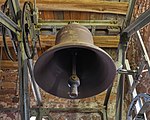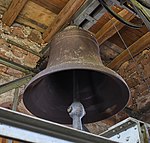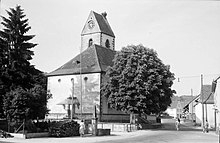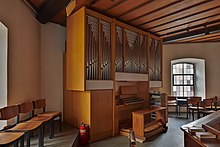St. Nikolaus (Hauingen)
The Church of St. Nikolaus in the Lörrach district of Hauingen is a Protestant church under the patronage of St. Nicholas . The church in the middle of the village was first mentioned in a document in 1103. Their structures come from different centuries. In 1759, the parents of Johann Peter Hebel were married here, which also makes the church the stadium of the Hebel hiking trail , which was launched in 2010 . With the introduction of the Reformation , the church name was not mentioned, instead it operated as the Evangelical Church in Hauingen. It was not until 2000 that it got its original name back.
history
Origins
The veneration of St. Nicholas began before 950. A St. Nicholas Church could have already existed. In old documents there are street and area names such as St. Nikolausmatten, St. Nikolausgarten or St. Nikolausreben, which suggest that a smaller church could have stood on the site of today's church. However, there are currently no archaeological findings. In the Markgräflerland there are or were a total of 19 St. Nicholas churches and chapels .
The first written mention of the church goes back to 1083. In the letter from 1102/1103 of the St. Alban monastery , the "Church of Hauingen with its members" (Latin: "ecclesiam de Houengen cum suis") is mentioned. The monastery had the right to appoint the priest or the pastor and to claim excess income from the parish. For this, the clergy were paid by the monastery and the church buildings were maintained.
The cross vault of the basement is believed to date from the 14th century. The church tower, which is still preserved today, has the date 1469 (" Anno Domini M CCCC LXIX") carved in on its east side . The tower probably rests on foundations that existed before.
The oldest known bell dates from 1653. It was cast by Hans Ulrich Rodt in Basel and shattered in 1909. The second, larger bell was from 1733. These two and the school bell from 1781, which was also cast in Basel, were made Melted down in 1909.
Leebel's parents were married
On July 30, 1759, the parents of Johann Peter Hebel , Johann Jakob from Simmern in the Electoral Palatinate and Ursula Hebel from Hausen im Wiesental , were married by Pastor Jacob Christoph Friesenegger. Since the employers of the Hebels parents at the time, the Iselins from Basel, arranged the wedding, they met about halfway between Hausen and Basel. In addition, two people of different denominations were not allowed to marry in Basel in the 18th century. The wedding is registered in the Hauingen church register. The entry reads:
"Under the Ministerio (service) of the pastor Jac.Christoph Friesenegger, who was graciously vocated (called) to this parish d, May 11, 1759 d. July 30th Joh.Jacob Helb, born in Simmern in the Chur-Palatinate, Reformed Relig., Weyl Joh.Nicolai Helbs Burgers u. Leinenweber's married unmarried son who survived there, same craft, with Ursula, weyl.Georg Örtlin, citizen and resident of Hausen, married unmarried daughter. "
Since July 26, 1959, a sandstone plaque donated by the Hebelbund Lörrach has been commemorating this wedding.
New construction of the nave
The increasing population of Hauingen made it necessary to enlarge the old nave. The choir stalls were renewed several times and in 1733 the margrave also planned a repair and expansion of the nave , which however did not materialize. The plans for a new building were only concretized with inspections in autumn 1766. With the new building begun in 1767, the dimensions of the church almost doubled compared to the previous building. The total costs were 6,414 guilders and 38 kreuzers , which the administration divided into Rötteln (4,276 guilders, 25 crosses, 2 5/9 pfennigs) and the St. Alban monastery (2,138 guilders, 12 kreuzers, 3 7/9 pfennigs). A memorial plaque above the door to the street, which has meanwhile been walled up, reminds of the new building.
The text of the foundation board reads:
"JNN ANIS DOMINI 1767–1768 this church was on the gracious command of S. Hochfürstlich Durchl (also) t of the ruling Mr. Marggraven Carl Friedrichs zu Baaden-Durl (oh) under the supervision of the spiritual administrator C.Phil. Helminger with the intention of the nave ad 2/3 and aside from the laudable Sift S (ankt) A (lban) zu Basel ratione of the choir ad 2/3 neu erb (a) ut u (nd) paid. What grace are praying for Pastor Jac (ob) Chr (stian) Friesenegger and Joh (an) n Jac (ob) Schneider Vogt zu Hauingen. - Haleluja. Expt: Rebstock "
Renovations and remodeling
The community commissioned the painter Johannes Scherren to make 33 wooden panels to decorate the gallery , which were attached in 1769. The representation differs in some details from the usual church images. For example, Jesus Christ is shown as the new Moses ; its rays emanating from the head are less reminiscent of the halo than of the radiant appearance of Moses. He is also holding the tablets with the Ten Commandments in his hand, just like him . For this reason, during the renovation of the church in 1851, the pictures were whitewashed by Scherren instead of restoring them, especially since that would have been significantly cheaper. However, the community successfully fought against it. During another renovation in 1919, there was another attempt to paint over the pictures. However, the painter Hermann Daur and the art professor Max Laeuger campaigned for the preservation of the gallery paintings .
In 1969/1970 the interior underwent a fundamental redesign. The interior was designed “across” and the late Rococo was destroyed. The altar, the pulpit and the baptismal font by Rudolf Scheurer are raised on the south wall. In addition, five new glass windows “Gemstones on the Way” based on designs by Jürgen Brodwolf were installed and the gallery shortened. The old pictures of the apostles can be seen today in the three-country museum.
In 2000 the church square was redesigned. In July 2015, the new chime went into operation after the bells had been out of order for months.
The church tower of St. Nikolaus will be renovated in summer 2020.
description
Church building
St. Nicholas Church in Hauingen is a cross hall church whose nave a simple, rectangular structure is defined by a abgewalmtes to the west and east gable roof is completed. The base measures around 12 × 25 meters. On the east side, three equally wide sides of five meters each of an octagon form the choir . The choir wall has two rows of windows on each of the three walls. In addition to the portal with a flight of stairs on the top, there are three oval, porthole-shaped windows on the west wall . On the south wall there are also nine windows in two rows, the memorial plaque for the new building from 1768 and a door that has meanwhile been bricked up, of which the old frame can still be seen.
Separated from the main structure, the 27 meter high bell tower stands directly on the northeast side and has a stork's nest on its top on its gable roof. The base of the tower is six meters. There is a clock on the east and west sides of the tower. The hewn, reddish ashlar stones on the edges stand out from the plastered wall surface. The tower hall is vaulted and decorated with fine ribs on consoles bearing the old Hachberg coat of arms.
The church has an entrance on the south-west and one on the north side. Between the church and pastor of with is cobblestone paved church square, from which can be reached from the main entrance to the north. Since 2010 an information board at the church has marked a station on the Hebel hiking trail . Opposite the Hauinger Church is on the opposite side of the street to the Hauinger Town Hall.
Going off the west entrance on the left is the staircase to the gallery . This runs from the west over the north to the east side. On the west and east sides, the additional seats are arranged slightly upwards towards the rear. Since the organ is on the east side, there are only seats on both sides of the instrument.
Furnishing
The interior is kept simple and simple. The benches have also given way to the redesign; the entire seating in the church consists of individual chairs. A noticeable feature is the gallery, which is also seated with 33 wooden panels by Johannes Scherren. The pictures contain the following motifs:
| Adam and Eve in Paradise | The temptation in paradise | Moses on the bush of fire |
| Moses receives the 10 commandments | Noah's Ark | Abraham and Isaac |
| Tower of Babel | Jacob's dream of the ladder to heaven | Daniel in the lions' den |
| Jonas and the whale | Annunciation | Adoration of Jesus by the shepherds |
| Worship by the 3 wise men | Circumcision of Jesus | Presentation in the temple |
| The Lord's Supper | Crucifixion of jesus | Resurrection of Jesus |
| Ascension of Jesus | Outpouring of the Holy Spirit (Pentecost) | Jesus with an olive branch and the ten commandments |
| Philip with a cross staff | James with fulling rod | Andreas with St. Andrew's Cross |
| Bartholomew with a knife | Matthias with a lance | Paul with sword and book |
| Peter with key | John with a chalice | James d. Ä. with pilgrim's staff |
| Simon with a saw | Thomas with Winkelscheid | Matthew with hatchet |
The altar is slightly raised on the south wall. In addition to a marble-shaped lectern and a table, the baptismal font is located in the altar area. The wall behind the altar is decorated with a simple cross with a figure of Jesus and an image of the Archangel Gabriel . The gallery is supported by six marble-shaped columns that stretch from floor to ceiling.
organ
Until 1909 there was an organ in the Nikolauskirche , which was commissioned in 1782 from the organ builder Blasius Bernauer (1740-1818) from Staufen im Breisgau , who was working in Rheinfelden at the time . It was bought as a bargain for 400 guilders and overhauled in 1807. However, after signs of wear and tear became noticeable over the centuries, the community decided in 1909 to purchase a new organ for 4600 Reichsmarks from GF Steinmeyer & Co. in Oettingen in Bavaria . It had ten registers and two manuals . The organ, largely financed by donations from Hauingers, had to be partially dismantled during the First World War . The prospect pipes had to be delivered to the army administration and could not be used again until 1924.
Since 1973 there has been a new organ in the choir on the east gallery. The instrument was built by Peter Vier in Oberweier near Lahr. It has one pedal , 13 registers and works with a twin drawer and mechanical play and stop action . In 2004 the organ was refurbished by the organ builder Späth from March- Hugstetten and an oboe reed register was added.
The current organ has the following original disposition :
|
|
|
||||||||||||||||||||||||||||||||||
Bells
After the old three bells were melted down in 1909, the community received two new bells. Both were cast in the Andreas Hamm bell foundry in Frankenthal in the Palatinate . The 505-kilogram g-bell and the 300-kilogram b-bell formed the minor bell. In addition to the names of Hauingen citizens, the opposite page read “To the glory of God - property of the community of Hauingen”. Due to the war, the smaller bell had to be delivered to the army administration on August 17, 1917 for 1,408.50 marks. As a replacement for this, a three hundredweight bronze d-bell was purchased in 1920. For this purpose, an eight-center bell with the tone b was cast by Bachert in Karlsruhe. The bells fell victim to World War II .
After the war, the Bochum association for cast steel production received the order to produce four new bells. They were consecrated on the 1st of Advent 1950. In 1977 a new citizen protested against the loudness of the bells, so that the pastor Gerhard Reis had the beating muffled. After a counter-protest against this action, the local administration ordered that the usual strike force be restored. After the control was defective in 2015, the four bells were alternately silent for several months. In July 2015 the problem was resolved again.
The current four bells from St. Nicholas from 1950 are:
| No. | image | Surname | Quoted Bible passage | Nominal | function |
|---|---|---|---|---|---|
| 1 |  |
Bethlehem | ( Lk 2.10–11 EU ) | f | Baptismal bell |
| 2 |  |
Wartburg | ( Rom 12.12 EU ) | as | Our Father |
| 3 |  |
homeland | ( 2 Cor 5,2 EU ) | b | Forerunners |
| 4th |  |
Golgotha | ( Joh 19.30 EU ) | c | Death knell |
The church chimes provide for the following schemes for the respective events:
- Main service:
- 1st chime at 9 a.m. with bell 3, 2nd chime at 9:30 a.m. with bell 3 for up to two minutes, then bell 2
- Main chimes from 9:50 to 10:00 a.m. with all bells for seven minutes, starting with bell 4 when switched off
- Funeral:
- 1. Prelude: 1 hour before bell 3 for two minutes
- 2. Prelim: 30 minutes before with bells 3 and 2 for two minutes
- Main chimes: 3 minutes before with bell 4 and 3
- Weddings:
- 1st chiming: 1 hour before bell 3
- 2nd ring: 30 minutes before bell 3 for two minutes, then switch off, wait, then bell 2
- Main chimes: all bells
- Consecration : bell 2
- Prayer time chimes: working days at 6 p.m., in summer at 7 p.m., Saturday at 6 p.m. to ring in Sunday with all four bells, Sundays not at all
- The bell rings at 11 a.m. every day except Sundays and public holidays
- The turn of the year: at 11:53 p.m. bell 4 to 11:58 p.m., after the clock strikes 12, all bells ring for ten minutes
literature
- Gerhard Moehring , Michael Fautz, Werner Heuer: Hauingen , A village book for the 900-year celebration (2002), pp. 218–237.
- Gerhard Moehring: Panel painting in the church Hauingen in: Our Lörrach . Verlag Kropf & Herz, Lörrach 1994, pp. 48-64.
- Otto Wittmann et al., Stadt Lörrach (ed.): Lörrach: Landscape - History - Culture , Verlag Stadt Lörrach, Lörrach 1983, ISBN 3-9800841-0-8 , pages 617–620.
- Johannes Helm : Churches and chapels in Markgräflerland , Müllheim / Baden 1989, ISBN 3-921709-16-4 , pp. 179-181.
- Carl Mennicke: The history of a Markgräflerkirche. In: Blätter aus der Margraviate , 1917, pp. 19–22 (digitized version of the Freiburg University Library)
Web links
Individual evidence
- ↑ Badische Zeitung : This is where lever's parents were married , article from January 7, 2016, last accessed on July 26, 2017
- ↑ a b Moehring, Fautz, Heuer: Hauingen , p. 218
- ^ Moehring, Fautz, Heuer: Hauingen , p. 223
- ↑ a b Moehring, Fautz, Heuer: Hauingen , p. 226
- ^ Moehring, Fautz, Heuer: Hauingen , p. 274
- ^ Moehring, Fautz, Heuer: Hauingen , pp. 228/229
- ↑ a b Lörrach: Landscape - History - Culture , p. 617.
- ^ Gerhard Moehring: Brief history of the city of Loerrach . Braun, Karlsruhe 2007, ISBN 978-3-7650-8347-1 , p. 132.
- ↑ Badische Zeitung : Fest mit Glockenklang , article from July 29, 2015, last accessed on July 26, 2017
- ^ Moehring, Fautz, Heuer: Hauingen , p. 237
- ↑ On the history of the Hauinger Church , last accessed on June 27, 2019
- ↑ according to the answer to the e-mail request to Martin Vier Orgelbau, Friesenheim of June 27, 2019
- ↑ Die Oberbadische : Hauinger bells strike again , article from July 24, 2015, accessed on July 21, 2019
- ^ Moehring, Fautz, Heuer: Hauingen , p. 227
- ↑ according to Ringing rules sent by e-mail from Pastor Martina Schüßler on July 23, 2019
Coordinates: 47 ° 38 ′ 35.5 ″ N , 7 ° 41 ′ 39.5 ″ E
















